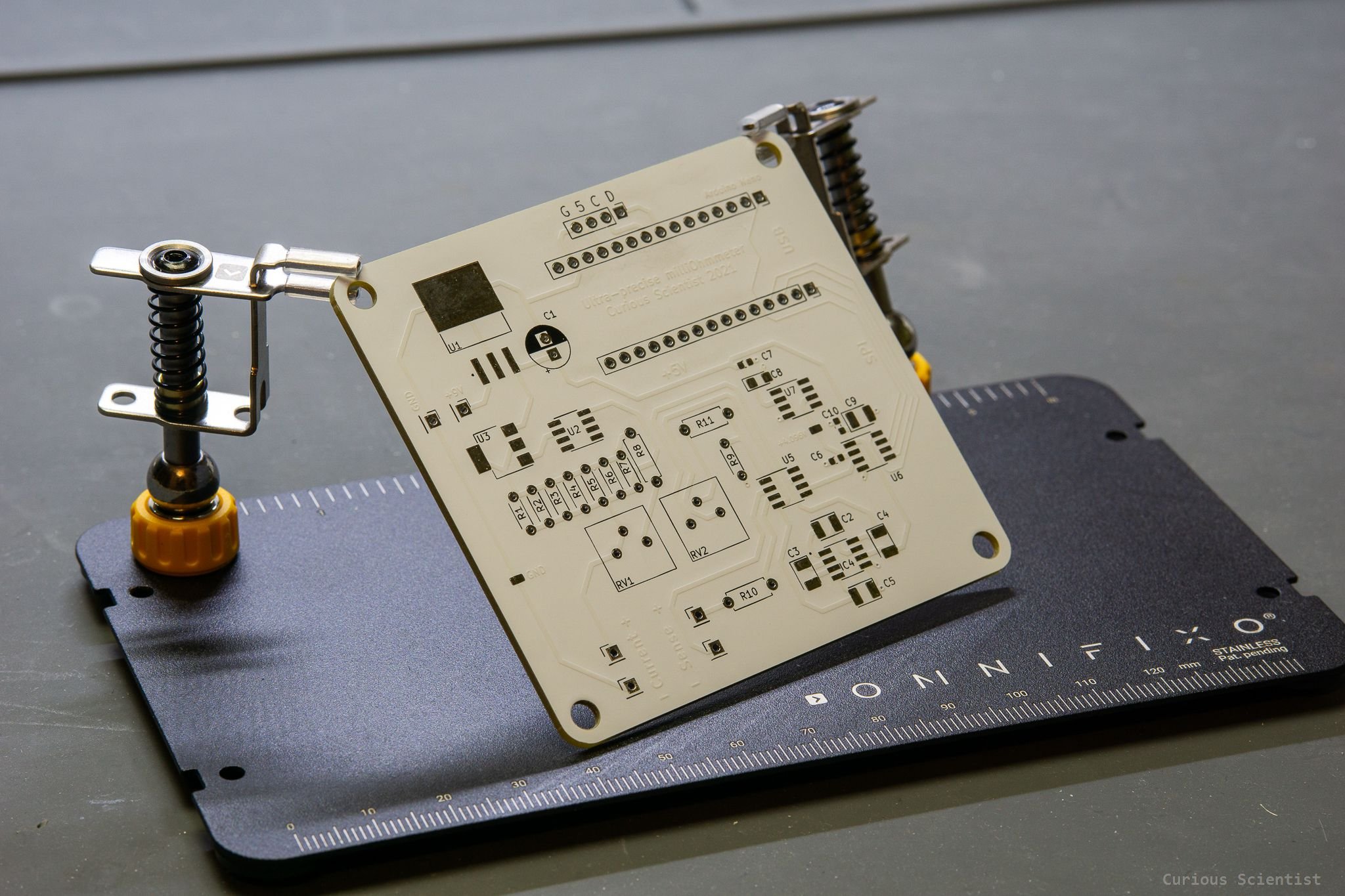Ultra-precise milliOhm meter - Part 2/2
In this video I demonstrate the capabilities of the device I assembled and then I show you the code. I haven’t done the current and voltage adjustment yet, because I need some precise resistors for the adjustment. Nevertheless, I get reasonably good values already. I show you how the circuit is built up, what components I used and how the measurement is done using the 4-wire sensing clips. I also spend a bit longer time explaining the principles of the AD converter. I show the ADC-readout in a very detailed way because the principles can be applied to most of the AD converters, so it is worth to know how the things work.
Arduino source code
#include <SPI.h> //for the ADC #include <Wire.h> //for the display //Display related #include <Adafruit_GFX.h> #include <Adafruit_SSD1305.h> #define OLED_RESET 9 Adafruit_SSD1305 display(128, 32, &Wire, OLED_RESET); //--------------------------------------------------- const int CS_pin = 10; long rawADCdata = 0; long registerData = 0; float voltage = 0; float current = 100; //100 mA float resistance = 0; float VREF = 4.096; void setup() { pinMode (CS_pin, OUTPUT); digitalWrite(CS_pin, HIGH); //For the ADC SPI.begin(); SPI.setBitOrder(MSBFIRST); SPI.setDataMode(SPI_MODE0); SPI.setClockDivider(SPI_CLOCK_DIV16); //----------------------------------------------------- Serial.begin(9600); //----------------------------------------------------- //For the display while (! Serial) delay(100); Serial.println("SSD1305 OLED test"); if ( ! display.begin(0x3C) ) { Serial.println("Unable to initialize OLED"); while (1) yield(); } display.clearDisplay(); display.setTextSize(1); display.setTextColor(WHITE); display.setCursor(0, 0); display.println(" Ultra-precise"); display.println(" milliOhm meter"); display.println(" Curious Scientist"); display.println(" 2022"); display.display(); delay(3000); } void loop() { calculateVoltage(); calculateResistance(); printOLED(); } void calculateResistance() { //R = U / I resistance = 1000 * (voltage) / current; //x1000 -> mOhm (because the current is in mA) Serial.print("Voltage: "); //print the average voltage Serial.print(voltage); Serial.println(" mV"); Serial.println(" "); //empty line Serial.print("Resistance: "); //print the resistance Serial.print(resistance, 2); Serial.println(" mOhm"); Serial.println("--------------------------------------------"); //Separator } void printOLED() { display.clearDisplay(); display.setTextSize(2); display.setTextColor(WHITE); display.setCursor(0, 0); //(x,y) display.print("R= "); display.setCursor(25, 0); display.print(resistance, 2); // display.setTextSize(1); display.setCursor(0, 16); display.print("U = "); display.setCursor(20, 16); display.print(voltage, 2); display.setCursor(70, 16); display.print(" mV"); // display.setCursor(0, 25); display.println("I = 100 mA, fixed"); display.display(); } void calculateVoltage() { //Zero the values to avoid mistakes in the summation rawADCdata = 0; voltage = 0; for (int i = 0; i < 10; i++) //read 10x { rawADCdata += readADC(); //read the ADC, put the raw data into a variable delay(200); //wait (conversion time) - see page 4. } rawADCdata /= 10; //divide it by the number of reads - averaging Serial.print("Raw bits: "); Serial.println(rawADCdata); Serial.println(" "); //empty line voltage = rawADCdata * 4.096 / (16777216) * 100; // *100 -> express it in mV (only 100, because the INA106 already gives a x10) } long readADC() { //How LTC2400 works? - Manual page 9-10. //3 steps: //1.) LTC2400 performs the conversion //2.) Enters a sleep state //3.) Once CS pulled low, the device exits the sleep state and it starts to output the results //The data consists of 32 bits. After all is shifted out CS automatically goes HIGH //Data format: //0000 | 0000 | 0000 | 0000 | 0000 | 0000 | 0000 | 0000 // a b c d e f g h //a: status information indicating the sign, input range and conversion state. bit 31 is the EOC -> LOW when conversion is done //b to g are conversion. b is the MSB //h: sub LSB, can be discarded //First, CS must go low to tell the ADC that we want the conversion results digitalWrite(CS_pin, LOW); //Then, we have to wait the D12 (MISO) pin to become available while (digitalRead(12) == 1) {} //we get stuck here until the pin 12 (MISO) is HIGH registerData = 0; //zero registerData to start clean registerData = SPI.transfer(0xff); //pull out the first byte -- 00000000 00000000 00000000 aaaabbbb registerData &= B00001111; //Remove the first four (a-part) bits and keep the rest which are part of the MSB -- 00000000 00000000 00000000 0000Bbbb (B = bit27 = MSB) registerData <<= 8; //MSB gets shifted LEFT by 8 bits -- 00000000 00000000 0000Bbbb 00000000 registerData |= SPI.transfer(0xff); //Mid-byte1 comes in and combined with the previous data -- 00000000 00000000 0000Bbbb cccccccc registerData <<= 8; //MSB+MID1 left shift: 00000000 0000Bbbb cccccccc 00000000 registerData |= SPI.transfer(0xff); //MSB+MID1 is combined with MID2 -- 00000000 0000Bbbb cccccccc dddddddd registerData <<= 8; //MSB+MID1+MID2 left shift: 0000Bbbb cccccccc dddddddd 00000000 registerData |= SPI.transfer(0xff); //MSB+MID1+MID2+LSB is combined -- 0000Bbbb cccccccc dddddddd eeeeeeee //Final, valid part is between the brackets: 0000[Bbbb cccccccc dddddddd eeee]eeee registerData >>= 4; //shift out 4 bits (sub-LSBs) // 00000000 Bbbbcccc ccccdddd ddddeeee digitalWrite(CS_pin, HIGH); return (registerData); }
Get the PCB from PCBWay
You can order my PCB through my affiliate link using PCBWay’s services. Click on the picture below and you will be redirected to PCBWay’s website.
